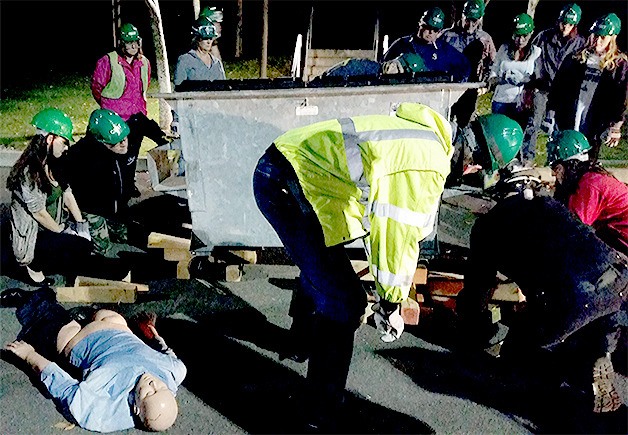In a disaster, your own safety is paramount. You can’t help others if you get hurt.
That was a key message in our fourth CERT training class Oct. 13. Matt Campbell, a captain with the Marysville Fire Department, was the instructor. The topic was “Light Search and Rescue Operations.”
The 25-member class learned that in a disaster involving buildings you have to size up the situation, search for victims and possibly extricate them. As in other aspects of our training we were told not to spend much time with each person so we can help the most people we can.
When deciding to attempt a rescue you have to figure out the risks involved and if you have the manpower to do it. If not, you’ll have to wait until more help is available. Get the walking wounded out first then rescue lightly trapped people next.
When sizing up a situation, assess the damage, consider probabilities, establish priorities, develop a plan of action, take action and evaluate constantly to see if changes are needed.
When assessing the situation note the time and day. If it’s a Sunday and you’re at a school at 11 a.m. there probably aren’t people there. But if you are at a church there may be. Note the building’s construction, the weather and any hazards, such as downed lines.
If damage to a building is minimal it is safe for rescuers to enter. Light damage means there are only broken windows, cracks in walls and minor damage to the interior. If a building has moderate damage, only enter to save a life. That building would still be on its foundation, but have major damage to the interior, breaks in walls and visible signs of damage. Lastly, never enter a building with heavy damage. It is too risky. It it’s collapsed, off its foundation and obviously not stable don’t enter under any circumstances. You can’t help others if you get killed yourself.
To keep safe, rescuers should try to wear safety equipment. Also, it’s best to work with a buddy system. When looking in buildings search areas where victims might seek safety, such as bathtubs, underneath desks, inside closets, under door jambs, under beds, etc.
If you are a member of a CERT team you actually will mark a building once it’s searched with an X. You will provide information such as the date, time you went in, time out, areas of building searched, and victims, living or dead, so that when emergency responders arrive they know what they are dealing with.
“That’s a huge weight off our shoulders,” Campbell said, adding the more information they get the more people they can help. “Our resources will be stressed, at best.”
When searching a building, ask, “Come here if you can here me.” That can help someone who is disoriented focus and get out. Those folks also can tell you if anyone else is inside and where they might be. Search from the bottom floor up or top down for multi-level buildings. For one-story buildings, search from the right wall to the left. Constantly listen for tapping, movement or voices.
Campbell, who has 19 years of experience, said when he worked the Oso landslide searchers started from the top down because most of the buildings were underground.
When attempting a rescue, create a safe environment by removing debris and objects. A bar or shovel can be used to lift objects off a trapped person. If the objects weigh too much, try to find something to use as a crib to provide leverage to help you lift. Campbell said a person can lift 24,000 pounds using four 4 by 4s. Go slowly and watch the load to make sure it doesn’t shift.
Once the victim is freed, the person can be carried to safety in a number of ways.
•If they are small enough, lift around their back and knees. Keep your back straight and lift with your knees.
•Put their arms over your shoulders and carry them on your back.
•You can lay them on a blanket and drag them to safety.
•With another person, one of you grabs under the legs and the other under the victim’s arms.
•With another person, seat the victim in a chair if one is available, and carry with one at the legs and the other at the back.
•If a few people are available, a victim can be carried in a blanket.
This is the fourth of a series on CERT training being attended and written by Steve Powell, managing editor of The Marysville Globe-The Arlington Times.



